British Army 'absolutely ready' if ordered to deploy to Ukraine
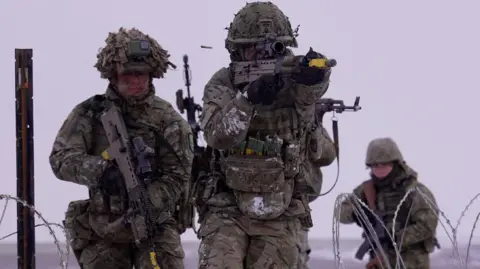 BBC
BBCThe British Army has said it is ready to deploy to Ukraine if requested by the government.
This week, 2,500 UK troops from the Army's high readiness force, the First Division, have been taking part in a large Nato exercise in Romania - on a training area just 16 miles (25km) from the border with Ukraine.
Although mobile phones have been banned on the exercise, most soldiers are aware that there are now initial discussions to send troops to Ukraine itself.
Brigadier Andy Watson, who is commanding the British contribution to the Nato exercise, says his brigade "is absolutely ready" should they receive orders to deploy to Ukraine.
Earlier this week Keir Starmer said that he was ready and willing to send British troops to Ukraine to help guarantee its security, should there be a ceasefire.
But so far he too is unclear as to what they might be asked to do.
In terms of numbers of troops that might be needed, Brigadier Watson said "clearly what the force package would look like would be dependent on what the prime minister and the Ministry of Defence would like".
But he said "it's absolutely not" something the UK could do on its own. "I think the prime minister has been very clear that the UK would contribute to efforts, but absolutely not doing it on our own," says Brigadier Watson.
Exercise Steadfast Dart is Nato's largest exercise this year and meant to demonstrate how quickly allies can come to the defence of an ally under attack. But while it's meant to demonstrate Nato's readiness, it also highlights its limitations too.
The UK has shown it can move large numbers of troops and equipment, including more than 700 military vehicles, 1,400 miles (2,253 km) across Europe at relatively short notice as part of Nato's new Allied Reaction Force.
And that it can operate alongside allies. More than 10,000 military personnel are taking part in the exercise from eight European nations.
But that is just 10% of the number that most military experts believe might be required for any peacekeeping operation inside Ukraine which might require a force of more than 100,000.
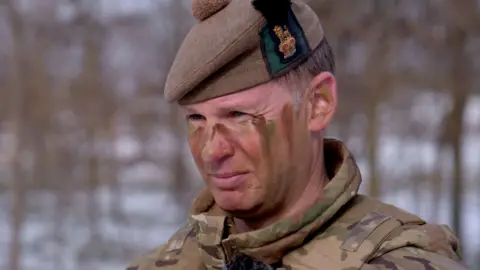
Some of the nations taking part, like Spain and Italy, have not even met Nato's own spending target for defence of 2% of GDP, set more than a decade ago. Many, including the UK, have experienced recent cuts in the size of their armed forces.
When British forces were sent to Helmand in 2009, the British Army had more than 100,000 regular troops.
Now it is at its smallest since the Napoleonic wars, at just over 70,000. Even before the cuts, the British Army was stretched sending a force of 9,000 troops.
It required additional defence spending for urgent operational equipment, as well as a rolling deployment of fresh troops every six months. A regular Army of around 73,000 would now struggle to do something on a similar scale.
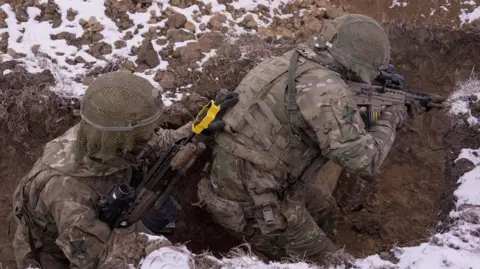
Steadfast Dart is meant to show that Nato's European allies can respond to a crisis.
Unusually, for a large Nato military exercise, US forces are not directly involved. But America remains Nato's most powerful and largest military member and its absence from any plan to guarantee Ukraine's security would leave a gaping hole.
That's why Keir Starmer and his Defence Secretary John Healey are calling for the US to be involved, despite the Trump administration's insistence that there will be no US boots on the ground.
Healey said on Tuesday that European nations would have to play a leading role but he added that "it is only the US that can provide the deterrence to Putin that will prevent him attacking again".
Nato's intervention in Libya in 2011 illustrated how European nations struggled without their biggest partner.
The US was supposed to take a back seat in the bombing campaign but was still heavily relied on for logistics - air-to-air refuelling - and providing intelligence and surveillance.
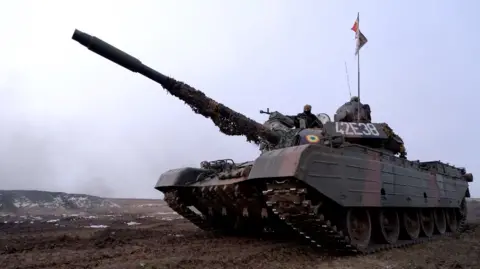
Back at Exercise Steadfast Dart, Colonel Gordon Muir, who commands 4 Scots troops and previously fought alongside the US in Afghanistan, said "there's a famous Highland saying - that friends are good on the day of battle". He said there are few circumstances when you want to go it alone.
Russia's full-scale invasion of Ukraine should have been the wake-up call that European nations needed. Most of its members are now spending 2% of their GDP on defence.
But Nato Secretary General Mark Rutte now says that is not enough and is pushing for more than 3%.
The Trump administration says it should be more like 5% of GDP. The UK government has still not set a date for its new spending target of 2.5%. Europe has also been slow to ramp up defence production.
But Exercise Steadfast Dart shows that some lessons are being learned from the war in Ukraine. There is an emphasis on trench and urban warfare as well as combatting drones.
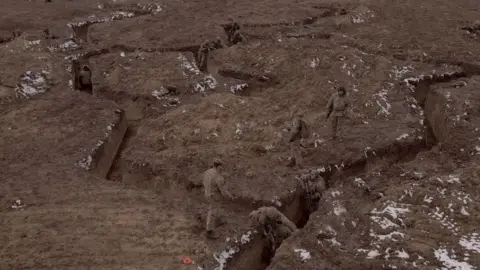
We watch British and Romanian troops repeat drills of clearing a recently excavated zigzag of snow-covered trench lines.
Many of the British troops taking part in this training have also recently been helping train their Ukrainian counterparts in the UK.
Corporal Richard Gillin, of 4 Scots, told me, "we're definitely ready for Ukraine".
Though they do not know whether such a deployment would happen - or what role they might be asked to perform - any operation in Ukraine would give the British Army a new sense of purpose and help with its recruitment crisis.
Lance Corporal Lewis Antwis, of the Royal Scots Dragoon Guards, said "people have joined the Army for a purpose…so yeah, I think the boys would be ready".
